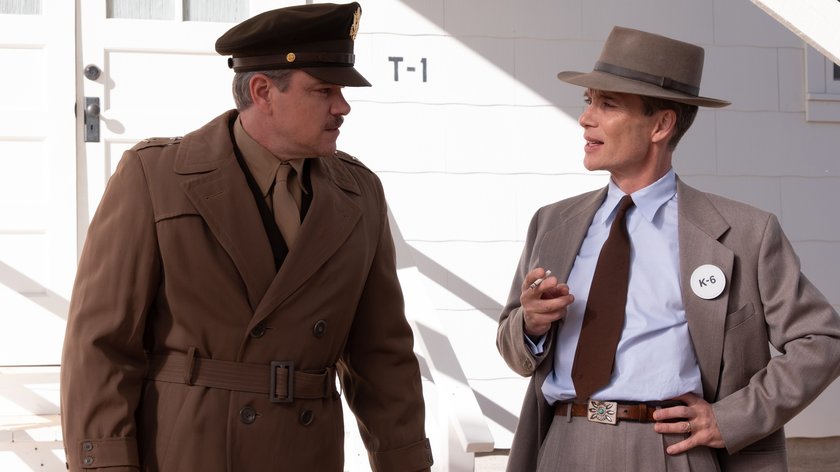
Christopher Nolan just can’t help himself: He also plays with the flow of time in his latest cinema hit “Oppenheimer“. We’ll bring some order to the matter for you.
On paper, “Oppenheimer” looks like the most narratively simple project of Christopher Nolan’s career. How complicated can you make a biopic? Well, the British director has once again found a way to play with the flow of time, as he has done in ‘Memento’, ‘Dunkirk’, and ‘Tenet’ (available to stream here on Amazon Prime Video). If you left the cinema a little confused, the following overview should hopefully provide some clarity, as we are arranging the events chronologically for you.
Study at Cambridge (1924-1926) The beginning of “Oppenheimer” also reflects the academic beginnings of the later physicist: Patrick Blackett (James D’Arcy) was Oppenheimer’s tutor in Cambridge, with whom he developed a hate relationship. The story with the poisoned apple is said to have really happened, and Oppenheimer escaped prosecution thanks to the efforts of his (rich) parents. The young student subsequently acted on probation at Cambridge and had to agree to seek psychiatric help. He had to complete the basic laboratory course, in which Oppenheimer did so amateurishly, as a condition for his admission to Cambridge, since his strengths lay in theory, and he had corresponding deficits in practice.
Studies in Göttingen (1926-1927) In Göttingen, then one of the leading places in theoretical physics, Oppenheimer completed his studies, which earned him a doctorate in 1927 at the age of 23. At this time, he also met the famous Werner Heisenberg (Matthias Schweighöfer).
Lectures in Leiden (autumn 1928) For a short time during his tenure at Cambridge and at Caltech, Oppenheimer gave a series of lectures in Leiden, The Netherlands. He surprised those present by actually delivering the lessons in Dutch, even though he hadn’t known the language for long. From this period comes his nickname “Opje,” which has been changed to “Oppie” in English.
Chair at Berkeley (1929-1943) Oppenheimer spent his longest time as a professor at the University of California at Berkeley, where he met, among others, the experimental physicist Ernest Lawrence (Josh Hartnett). With his work there, Oppenheimer helped quantum physics become more popular in the USA. However, he also became conspicuous through a “discussion group” that he chaired from 1937 to 1942, which in reality was a closed and halfway secret group of the Communist Party.
Relationships with Jean Tatlock and Katherine Puening (from 1936) In 1936, Oppenheimer met Jean Tatlock (Florence Pugh), daughter of a Berkeley literature professor, and a Stanford medical student. Tatlock also wrote for a Communist Party newspaper. She ended the stormy relationship in 1939.
In August of that year, Oppenheimer met Katherine “Kitty” Puening (Emily Blunt), a former member of the Communist Party. Although she was married three times at the time, she began an affair with the physicist and spent the summer of 1940 on his ranch in New Mexico. The two were married on November 1, 1940, after Katherine filed for divorce from her husband as she was pregnant by Oppenheimer. Their first child, Peter, was born in May 1941, their daughter Katherine, called Toni, on December 7, 1944, in Los Alamos.
In 1943, Oppenheimer met Jean Tatlock again. She suffered from depression and took her own life on January 4, 1944, which hit Oppenheimer hard.
Manhattan Project (1942-1945) Lieutenant General Leslie Groves (Matt Damon) appointed Oppenheimer to lead the Manhattan Project in September 1942, surprising many at the time. Groves himself was skeptical as to whether other physicists would respect Oppenheimer without the Nobel Prize. But he valued Oppenheimer for his ambition and broad field of interest, both of which he saw as essential to the success of the Manhattan Project.
The high point of the project was the Trinity test on July 16, 1945, when the first atomic bomb in human history was successfully detonated near Alamogordo in New Mexico. Oppenheimer later claimed that during the explosion, the famous quote from the Bhagavad Gita, a sacred scripture of Hinduism, came to his mind: “Now I am become Death, the destroyer of worlds.”
On August 6, 1945, on the evening of the atomic bombing of Hiroshima, Oppenheimer addressed a gathering in Los Alamos. Among other things, he expressed his regret that the atomic bomb was not ready in time to use it against Nazi Germany.
In October 1945, the physicist had a meeting with US President Harry S. Truman (Gary Oldman). However, this came to an abrupt end after Oppenheimer complained that he felt blood on his hands. Truman was upset by the comment and reportedly later told his Under Secretary of State, “I never want to see that son of a bitch in this room again.”
Lewis Strauss brings Oppenheimer to Princeton (1947) Two years after the end of World War II, J. Robert Oppenheimer accepted an offer from Lewis Strauss (Robert Downey Jr.) to direct the Institute for Advanced Study at Princeton. Immediately after his arrival, one of the most crucial scenes in “Oppenheimer” occurs: the eponymous hero meets Albert Einstein (Tom Conti) and shares with him his fear that his achievement may have really brought ruin to the world. Einstein’s stricken face misinterprets Strauss in the film and believes that Oppenheimer incited Einstein against him.
Oppenheimer disgraces Strauss (1949) The next important event in the Oppenheimer-Strauss feud occurs two years later: Before the US Congress, amateur physicist Strauss expressed his concerns about exporting radioactive isotopes to other countries. Oppenheimer ridiculed this by saying that these isotopes are less important than electronics but still more important than vitamins.
First Soviet Union atomic bomb test (August 1949) Strauss and Oppenheimer also disagreed on the subject of the hydrogen bomb. After the Second World War, Oppenheimer advocated the use of nuclear weapons and feared that the more powerful hydrogen bombs could be used to destroy entire cities with over a million inhabitants. The conflict flared up again when the Soviet Union tested its first atomic bomb in August 1949. In search of a possible answer and to get ahead in the nuclear race again, Oppenheimer and Strauss had a lively discussion about the possibility of building hydrogen bombs.
Security Hearing (1953-1954) Excerpts from this epoch in Oppenheimer’s life are repeatedly intercut as one of two time levels in Christopher Nolan’s film: In the course of the McCarthy era, during which real or supposed communists in the USA were vehemently persecuted, also with the help of the FBI, J. Robert Oppenheimer became a target. The safety hearing was triggered behind closed doors on November 7, 1953, by William Liscum Borden (David Dastmalchian), former executive director of the United States Congress Joint Committee on Atomic Energy. In a letter to FBI Director J. Edgar Hoover, he had claimed that Oppenheimer was likely a Soviet agent.
On December 21, 1953, Strauss informed Oppenheimer that his security clearance had been revoked, prompting the physicist to request a security hearing. One of the key aspects of the hearing was the story, according to Oppenheimer, which he fabricated to Boris Pash (Casey Affleck) in an earlier testimony, that George Eltenton (Guy Burnet) had contacted several scientists at Los Alamos. Eltenton said he had ways of getting information back to the Soviet Union, which Oppenheimer allegedly was told by his friend Haakon Chevalier (Jefferson Hall). This gave rise to the unsavory suspicion that Oppenheimer had paved the way for findings from the Manhattan Project to reach the Soviet Union.
The testimony of his colleague Edward Teller (Benny Safdie) was also fatal to Oppenheimer. Although he did not doubt Oppenheimer’s loyalty to the USA, he nevertheless expressed concerns about his security clearance, since Teller could not understand his views on a number of points – including the hydrogen bomb – and these were not in the interest of the country.
Oppenheimer’s security clearance was ultimately withdrawn one day before it expired because Oppenheimer’s behavior during the hearing was considered unstable and a possible security risk. As a result, Oppenheimer lost his influence on US nuclear policy, and his public image was damaged.
Strauss fails in Senate vote (1959)
The second time level, which is repeatedly shown in “Oppenheimer,” is particularly noticeable due to the black and white scenes (the meaning of which is explained by Christopher Nolan here). President Robert D. Eisenhower nominated Lewis Strauss as Secretary of Commerce in 1958, but the nomination failed a year after Eisenhower won when the US Senate blocked Strauss’ nomination. We view this Senate hearing primarily from Strauss’s perspective, whose personal vendetta against Oppenheimer and his orchestration of the security hearing against him are previously laid bare here. In fact, several high-ranking scientists railed against Strauss during the Senate hearing over his dealings with Oppenheimer.
Oppenheimer is decorated by the US President (1963) Oppenheimer experienced a kind of rehabilitation from US President John F. Kennedy, who awarded him the Enrico Fermi Prize in 1963. This award is given to people who have made outstanding contributions to the development, use, or control of nuclear energy.




